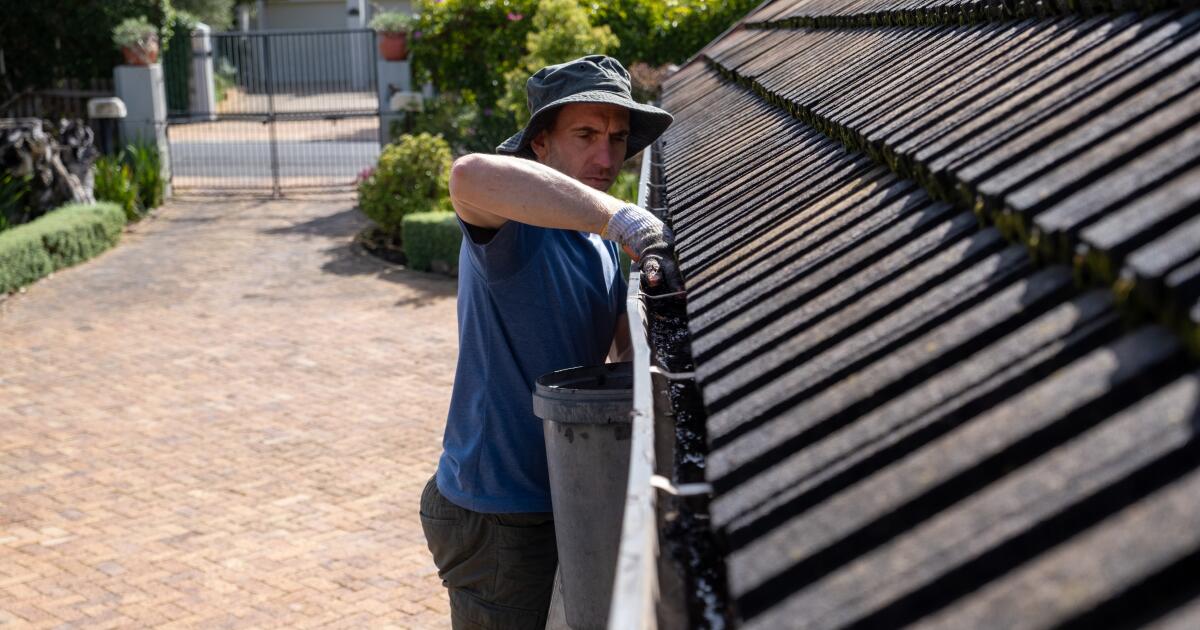
December is gift-giving time, and what better gifts to give your gardening besties (or yourself) than the opportunity to become a better gardener?
That’s the goal of Garden School, the gardening program designed specifically for San Diego and Southern California gardeners. Visit waterwisegardener.com for more information and to sign up.
Prepare for rain
Weather forecasters tell us to prepare for El Niño, which is a wet winter weather pattern. Climate change researches say to expect strong but intermittent storms overall, so with El Niño, rainfall may be extreme. While rain doesn’t hurt plants, the side effects of the rain might.
- Clean out rain gutters so water falling onto the roof goes into the downspout rather than off the edge of the roof and flattens all the plants beneath. Compost the debris or use it as mulch.
- Direct water from your roof’s downspouts to capture rainfall and store in a cistern. Use that water to irrigate plants during dry periods. Some cisterns are installed above ground, others are buried underground and out of sight. These storage systems are made of concrete, fiberglass and polyethylene.
- Water cisterns can hold hundreds to thousands of gallons. Choose a size based on the size of your roof. Water capture is typically 62 gallons of water from every 1,000 square feet of roof. Direct downspouts from the roof to the cistern.
- As you prepare planting beds, create opportunities to shape the soil to include dips and swales to capture water so it can percolate into the surrounding soil. Bank water now to make it available for long-term withdrawal by plant roots in spring.
- Low spots where rainwater collects are also opportunities for swales. As you construct a swale, line the bottom with several inches of woody mulch. The mulch absorbs water and holds it so it can percolate into the water slowly. The idea is to bank the water in the soil so it can be accessible to plant roots.
- Remove weedcloth, landscape fabric and plastic sheeting under mulch. We want the rain to percolate into the soils, but these materials prevent that from happening and turn the soil below as hard as concrete and impermeable to water.
- Bare hillsides are at huge risk of erosion, even mudslides, in the rains. String straw-filled or compost-filled wattles across hillsides to slow water on its way downhill. Alternatively — or in combination — spread lengths of landscape burlap (also called “landscape jute fabric”) over the bare dirt.
- Replant iceplant-covered slopes with woody trees and shrubs. First, because iceplant is invasive, and second, because in heavy rains, iceplant can slide downhill in sheets. Remediation is expensive and messy, so be proactive, not reactive.
- Prune trees carefully so the weight of wet leaves won’t bend or break branches.
- Until we get rain, continue to run irrigation once every week, two weeks or month, depending on the types of plants each zone irrigates. As the seasons change, adjust the frequency of irrigation, but always run the water for the same number of minutes.
- Empty water that accumulates in dishes under potted plants, buckets, containers and other places where the constant moisture can drown plant roots or become a mosquito nursery. (This applies to all times of year, not just the rainy season.)
- After the rain, stay off the soil for two days. Wet soil compacts easily, so rather than dig or weed or plant, do chores like repotting plants, cleaning your toolshed and planning for spring.
- Be sure to run your irrigation the day before any Santa Ana winds are expected. Saturating the soil protects plants from desiccation.
Update ornamentals
One of the most important ways to manage water is by carefully choosing and managing plants. This is THE time of year to plan and implement a drought resilience strategy.
- Look for plants with narrow leaves, tiny leaves, succulent leaves, fuzzy leaves, silvery leaves, hard leathery leaves, and/or needles. These adaptations help plants conserve water in the hot months.
- Native mallow plants are great ways to bring color and pollinators to your garden. Palmer’s mallow (Abutilon palmeri) has fuzzy, blue-green leaves and golden yellow flowers. The plants grow 5 feet tall and wide, and bloom almost year-round. Lavender flowered chaparral mallow (Malacothamnus fasciculatus) grows 6 to 8 feet tall and wide with small, silvery-green leaves. Bushtits love to build their long, socklike nests amidst the branches. Desert mallow (Sphaeralcea ambigua) has deeply grooved, silver-green leaves and bright orange flowers. My favorite is ‘Louis Hamilton’ desert mallow, whose flowers are the color of ripe watermelons. All of these plants thrive in full sun, lean soils and hot conditions.
- Every garden needs drought-resilient trees — as many as possible. Island oak (Quercus tomentella) grows fast to about 35 feet tall and wide, while cork oak (Quercus suber) grows a bit taller and wider. These lesser-known oaks thrive in full, hot sun without irrigation once established. They are excellent shade trees and support a host of wildlife.
- Succulent aloes put on a beautiful show this time of year. One of my favorites is Aloe rubraviolaceae, a low-growing rosette type Aloe whose teal leaves are edged in soft rose. Each rosette features a single, tall candelabra of stout, poker-style flowers that bloom red-orange.
- Try some large succulents in your landscape: Mexican grass tree (Dasylirion longissimum) is native to Hidalgo and Queretaro in Mexico, Big Bend yucca (Yucca rostrata) from Chihuahua and Coahuila in Mexico, grass tree (Xanthorrhoea preisii) is native to Australia. All of these plants share a striking a resemblance, with their highly sculptural forms; long, narrow blades that emanate from a central point and move gently in a breeze. Yucca rostrata blades are a bit flattened and very blue. Mexican grass tree blades are long, narrow, pointed and green, while (Australian) grass tree’s head of green blades are graceful and almost luxurious looking.
Prepare for cold
While we don’t get hard frosts, plants from coast to mountains can suffer frost damage on a cold night.
- Protect cold-sensitive plants like Plumeria, bromeliads, some kinds of succulents, etc. Move potted plants under the eaves or under low branches of evergreen trees. Cover in-ground plants with floating row cover (NOT plastic and not a bed sheet). Use clothespins to secure the cover in place.
- Do not cut off the damaged parts of a frosted plant — they protect the rest of the plant from the next freezes. Wait until February or March once all danger of frost has passed.
Fruit trees
- How much “chill” does your garden get? In our warm winter climate, we are limited to growing “low chill” peaches, plums, nectarines, and other stone fruits, along with apples and pears. Without enough cold, the plants don’t get enough dormancy. As a result, they may not flower, nor will they make fruits. San Diego County chill hours range from 100 hours along the coast to 1000 hours in Julian. Download a map of the county’s chill hours at bit.ly/ChillHoursSanDiego.
- Bare root blueberries, figs, and pomegranates already available in local nurseries. Next month, bareroot fruit trees and shrubs begin to arrive: peaches, apples, nectarines, pears, apricots, and more.
- What’s my favorite apple? Sundowner! This apple is sweet, tart, crisp. It is excellent eaten right off the tree and also makes great pies and apple sauce. And Sundowners ripen in October/November, which is after summer’s fruit is done, and before winter citrus.
This is the most important maintenance time for deciduous fruit trees like peaches, nectarines, pluots, apriums, apples and others that drop their leaves in winter.
Between now and the end of January:
- Strip leaves off the branches of stone fruits, pears, and apples if they don’t fall off on their own. Leaves can be infected with fungus and other pathogens that overwinter. Don’t compost them. Rake them up instead, then send them off in the greenwaste.
- Prune deciduous fruit trees taking care NOT to cut off the fruiting wood. Different kinds of fruit trees form fruits on a different parts of their branches. Apples, for example, grow short spurs along the branches. Those spurs make flowers and fruits. Pomegranates and figs fruit at the end of branches. Pluots fruit along the length of the branch. Know what fruits before you cut.
- My favorite pruning guide is “How to Prune Fruit Trees” by R. Sanford Martin. It’s a classic!
- After pruning, spray fruit trees to kill overwintering pests and diseases. Spray each treatment once, wait two weeks, spray again, wait two weeks and spray a third time.
- Spray apple and pear trees with mineral-based horticultural oil to suffocate scale, whiteflies, mealy bugs and other tiny pests that overwinter in the bark.
- Spray stone fruits (peach, nectarine, plum, etc.) with liquid copper to kill the fungus responsible for the dreaded peach leaf curl. Spray mineral-based horticultural oil, too.
- Every time you spray, coat all branches and trunks, from tips to base. The better the coverage, the more your trees are protected.
- If you have lots of fruit trees, consider a battery-powered sprayer. Battery-powered sprayers are more expensive than hand pump but are easier to use, far faster and much more effective.
Prune established ornamentals
- Winter is time to prune ornamental trees and shrubs. Hire a certified arborist to remove weak or dead branches, check for borer infestations, structural integrity and so on. If you don’t have a favorite certified arborist, find one at treesaregood.org.
- Before you prune, clean and sharpen your pruning tools so they make clean, healthy cuts that don’t shred the wood.
- Work clean. Disinfect pruning shears, saws, loppers and other cutting tools before and between plants to avoid spreading diseases and pests from one plant to the next. I use household disinfectant spray.
- To prune, first remove dead branches, weak wood, and crossing branches. Then prune for shape.
- Make cuts in the right spot. Follow each branch to where it attaches to the trunk or to the next larger branch. Notice the swelling at the base of the branch? That’s called the branch collar. When you cut, cut up to the branch collar, leaving no stubs behind.
- NEVER top a tree. If a tree is too tall, replace it with one (or two or three) that doesn’t grow that tall.
- Each time you finish pruning, spray your tools, wipe them dry and lubricate them with mineral oil before storing.
Care for potted plants
- It’s poinsettia time! Remove the fancy foil as soon as you get poinsettia home. Make sure its pot has drainage holes. If it doesn’t, move the plant to a new pot with drainage. Place it in a brightly lit room away from the heater vent and away from a cold window. Water enough to keep the soil damp but not wet. Don’t fertilize until after the holidays. Watch the fascinating story of poinsettias, how they are created, how they came to represent the holiday season and more at agrowingpassion.com/poinsettias-holiday-season.
- Monitor potted plants. Feel the potting soil every few days and water before the soil gets too dry. Indoors, a humidifier helps keep air moist and plants from drying out.
- Control pesky little black fungus gnats, which are attracted to the wet, decaying organic matter in the potting soil. The flies are easy to control without chemicals or sprays: 1) water less (your plants will be fine) and 2) use a ½- to 1-inch-thick layer of small pebbles, aquarium rocks, even marbles to cover the surface of the potting soil. That forms a barrier the flies can’t penetrate.
Edible gardens
- All summer veggie plants should be long gone. Even if your tomato or pepper or eggplants are still producing, next year they won’t be nearly as productive and vigorous. Pull them out and start seeds again in March or April.
- Before you replant pots or raised beds, add compost to bring the soil level back to the top. Sprinkle in earthworm castings and vegetable fertilizer.
- Plant winter root vegetable seeds (not seedlings) now: beets, turnips, radishes, carrots, rutabagas, parsnips.
- Plant greens and cabbage family plants from seed or seedling: lettuce, spinach, kohlrabi, kale, Brussels sprouts, cabbage, cauliflower, broccoli and more.
- Plant annual parsley, dill and cilantro from seed. These annual herbs do best in vegetable gardens.
- Plant perennial oregano, thyme, marjoram, sage and rosemary from 4-inch or 1-gallon pots into a permanent spot in the garden. Plant these waterwise Mediterranean natives with your permanent ornamental plants.
- To harvest greens like lettuce, kale, spinach, bok choy and tatsoi, simply cut off as many leaves as you need, and let the plants continue to grow. Harvest herbs the same way.
Mulch
- How thick is your garden’s mulch? Aim for a minimum of 3 inches over every garden bed. Be sure irrigation lines are under the mulch, not on top.
- Mulch succulents with rock or gravel. Mulch nonsucculents with aged woody mulch or with fresh wood chips that are smaller than an inch. Larger fresh woodchips can bring deadly borers into your garden. Aged wood chips are not problematic.
Sterman is a garden designer, journalist and the host of “A Growing Passion” on public television. She runs Nan Sterman’s Garden School at waterwisegardener.com.







